1&1 Dsl Bestandskunden Angebote Zur Vertragsverlängerung
 Model of the Voyager spacecraft pattern | |
| Mission type | Outer planetary, heliosphere, and interstellar medium exploration |
|---|---|
| Operator | NASA / Jet Propulsion Laboratory |
| COSPAR ID | 1977-084A[i] |
| SATCAT no. | 10321[ii] |
| Website | voyager |
| Mission duration |
|
| Spacecraft properties | |
| Spacecraft type | Mariner Jupiter-Saturn |
| Manufacturer | Jet Propulsion Laboratory |
| Launch mass | 825.5 kg (1,820 lb) |
| Ability | 470 watts (at launch) |
| Start of mission | |
| Launch date | September 5, 1977, 12:56:00 (1977-09-05UTC12:56Z) UTC |
| Rocket | Titan IIIE |
| Launch site | Cape Canaveral Launch Complex 41 |
| Stop of mission | |
| Last contact | TBD |
| Flyby of Jupiter | |
| Closest approach | March v, 1979 |
| Distance | 349,000 km (217,000 mi) |
| Flyby of Saturn | |
| Closest arroyo | November 12, 1980 |
| Distance | 124,000 km (77,000 mi) |
| Flyby of Titan (atmosphere report) | |
| Closest approach | November 12, 1980 |
| Distance | 6,490 km (4,030 mi) |
| Flagship | |
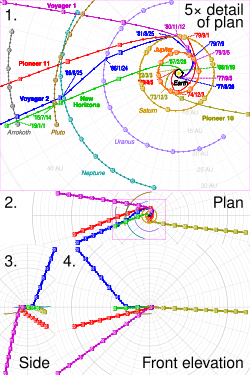
Voyager 1 is a space probe launched past NASA on September 5, 1977, as role of the Voyager plan to written report the outer Solar System and interstellar space beyond the Sun's heliosphere. Launched 16 days after its twin Voyager 2, Voyager 1 has been operating for 45 years and 20 days equally of September 26, 2022 UTC [refresh] and still communicates with the Deep Space Network to receive routine commands and to transmit information to Globe. Real-time distance and velocity data is provided past NASA and JPL.[three] At a distance of 157.77 AU (23.602 billion km; 14.666 billion mi) from Earth as of September 20, 2022[update],[3] it is the well-nigh distant humanmade object from Earth.[4]
The probe fabricated flybys of Jupiter, Saturn, and Saturn'due south largest moon, Titan. NASA had a choice of either doing a Pluto or Titan flyby; exploration of the moon took priority because information technology was known to take a substantial temper.[v] [6] [7] Voyager 1 studied the weather, magnetic fields, and rings of the two gas giants and was the offset probe to provide detailed images of their moons.
Equally role of the Voyager programme and like its sister craft Voyager two, the spacecraft's extended mission is to locate and written report the regions and boundaries of the outer heliosphere and to brainstorm exploring the interstellar medium. Voyager i crossed the heliopause and entered interstellar space on August 25, 2012, making information technology the get-go spacecraft to exercise so.[8] [9] Two years later, Voyager 1 began experiencing a third "tsunami wave" of coronal mass ejections from the Sun that continued to at to the lowest degree December fifteen, 2014, further confirming that the probe is indeed in interstellar space.[10]
In a further testament to the robustness of Voyager i, the Voyager team tested the spacecraft'southward trajectory correction maneuver (TCM) thrusters in late 2017 (the first time these thrusters had been fired since 1980), a projection enabling the mission to be extended by two to three years.[11] Voyager one 's extended mission is expected to continue until about 2025, when its radioisotope thermoelectric generators (RTGs) will no longer supply enough electric power to operate its scientific instruments.[12]
Mission background [edit]
History [edit]
In the 1960s, a M Tour to study the outer planets was proposed which prompted NASA to begin piece of work on a mission in the early on 1970s.[13] Information gathered by the Pioneer 10 spacecraft helped Voyager'due south engineers design Voyager to cope more than effectively with the intense radiation environment effectually Jupiter.[xiv] However, presently before launch, strips of kitchen-grade aluminum foil were applied to certain cabling to further enhance radiations shielding.[15]
Initially, Voyager 1 was planned every bit "Mariner 11" of the Mariner plan. Due to upkeep cuts, the mission was scaled back to exist a flyby of Jupiter and Saturn and renamed the Mariner Jupiter-Saturn probes. Every bit the program progressed, the name was later changed to Voyager, since the probe designs began to differ profoundly from previous Mariner missions.[16]
Spacecraft components [edit]

Voyager ane was constructed by the Jet Propulsion Laboratory.[17] [xviii] [19] It has 16 hydrazine thrusters, three-axis stabilization gyroscopes, and referencing instruments to keep the probe'south radio antenna pointed toward Earth. Collectively, these instruments are function of the Attitude and Articulation Control Subsystem (AACS), along with redundant units of most instruments and 8 backup thrusters. The spacecraft also included eleven scientific instruments to study celestial objects such equally planets as it travels through space.[20]
Communication system [edit]
The radio communication system of Voyager 1 was designed to be used up to and beyond the limits of the Solar System. The communication arrangement includes a 3.7-meter (12 ft) diameter high gain Cassegrain antenna to send and receive radio waves via the three Deep Infinite Network stations on the Earth.[21] The craft normally transmits information to Earth over Deep Space Network Channel 18, using a frequency of either 2.3 GHz or 8.four GHz, while signals from Earth to Voyager are transmitted at two.1 GHz.[22]
When Voyager one is unable to communicate directly with the World, its digital record recorder (DTR) tin can tape virtually 67 megabytes of information for transmission at another time.[23] As of 2021[update] signals from Voyager 1 take over 21 hours to reach Earth.[3]
Power [edit]
Voyager 1 has three radioisotope thermoelectric generators (RTGs) mounted on a boom. Each MHW-RTG contains 24 pressed plutonium-238 oxide spheres.[24] The RTGs generated about 470 W of electric power at the time of launch, with the residuum being dissipated as waste heat.[25] The ability output of the RTGs declines over time due to the 87.seven-twelvemonth half-life of the fuel and degradation of the thermocouples, but the arts and crafts'south RTGs volition continue to support some of its operations until 2025.[twenty] [24]
-
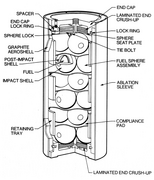
Diagram of RTG fuel container, showing the plutonium-238 oxide spheres
-
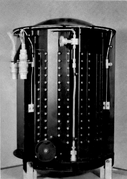
Model of an RTG unit of measurement
Equally of September 26, 2022, Voyager 1 has 70.04% of the plutonium-238 that information technology had at launch. Past 2050, it volition have 56.v% left, far too little to continue information technology functional. By 2078, it will have 42.96% left. By 2106, it will have 29.42% left. Past 2134, information technology volition take 15.88% left. By July xviii, 2167, the fuel will have rust-covered into lighter elements.
Computers [edit]
Unlike the other onboard instruments, the operation of the cameras for visible light is non autonomous, just rather it is controlled past an imaging parameter table independent in one of the on-lath digital computers, the Flying Information Subsystem (FDS). Since the 1990s, most space probes have been equipped with completely autonomous cameras.[26]
The estimator control subsystem (CCS) controls the cameras. The CCS contains fixed computer programs, such as command decoding, error-detection and -correction routines, antenna pointing routines, and spacecraft sequencing routines. This computer is an improved version of the one that was used in the 1970s Viking orbiters.[27]
The Attitude and Articulation Control Subsystem (AACS) controls the spacecraft orientation (its mental attitude). It keeps the high-gain antenna pointing towards the Earth, controls attitude changes, and points the scan platform. The custom-built AACS systems on both Voyagers are the aforementioned.[28] [29]
Scientific instruments [edit]
| Instrument proper noun | Abr. | Description | ||||||||||||||||||||||||||||||||||||||||||||||||||||||||||||||||||||||||||||||||||||||||||||
|---|---|---|---|---|---|---|---|---|---|---|---|---|---|---|---|---|---|---|---|---|---|---|---|---|---|---|---|---|---|---|---|---|---|---|---|---|---|---|---|---|---|---|---|---|---|---|---|---|---|---|---|---|---|---|---|---|---|---|---|---|---|---|---|---|---|---|---|---|---|---|---|---|---|---|---|---|---|---|---|---|---|---|---|---|---|---|---|---|---|---|---|---|---|---|
| Imaging Science System (disabled) | (ISS) | Utilized a two-photographic camera system (narrow-angle/wide-angle) to provide images of Jupiter, Saturn and other objects along the trajectory. More
| ||||||||||||||||||||||||||||||||||||||||||||||||||||||||||||||||||||||||||||||||||||||||||||
| Radio Science Organization (disabled) | (RSS) | Utilized the telecommunications system of the Voyager spacecraft to determine the physical properties of planets and satellites (ionospheres, atmospheres, masses, gravity fields, densities) and the amount and size distribution of material in Saturn's rings and the ring dimensions. More
| ||||||||||||||||||||||||||||||||||||||||||||||||||||||||||||||||||||||||||||||||||||||||||||
| Infrared Interferometer Spectrometer (disabled) | (IRIS) | Investigates both global and local energy residue and atmospheric composition. Vertical temperature profiles are also obtained from the planets and satellites equally well as the composition, thermal properties, and size of particles in Saturn'south rings. More
| ||||||||||||||||||||||||||||||||||||||||||||||||||||||||||||||||||||||||||||||||||||||||||||
| Ultraviolet Spectrometer (disabled) | (UVS) | Designed to measure atmospheric properties, and to measure out radiation. More
| ||||||||||||||||||||||||||||||||||||||||||||||||||||||||||||||||||||||||||||||||||||||||||||
| Triaxial Fluxgate Magnetometer (agile) | (Magazine) | Designed to investigate the magnetic fields of Jupiter and Saturn, the interaction of the solar wind with the magnetospheres of these planets, and the magnetic field of interplanetary space out to the purlieus betwixt the solar current of air and the magnetic field of interstellar space. More
| ||||||||||||||||||||||||||||||||||||||||||||||||||||||||||||||||||||||||||||||||||||||||||||
| Plasma Spectrometer (defective) | (PLS) | Investigates the microscopic backdrop of the plasma ions and measures electrons in the energy range from 5 eV to 1 keV. More than
| ||||||||||||||||||||||||||||||||||||||||||||||||||||||||||||||||||||||||||||||||||||||||||||
| Low Energy Charged Particle Instrument (active) | (LECP) | Measures the differential in energy fluxes and angular distributions of ions, electrons and the differential in free energy ion limerick. More
| ||||||||||||||||||||||||||||||||||||||||||||||||||||||||||||||||||||||||||||||||||||||||||||
| Catholic Ray System (agile) | (CRS) | Determines the origin and acceleration process, life history, and dynamic contribution of interstellar cosmic rays, the nucleosynthesis of elements in catholic-ray sources, the behavior of catholic rays in the interplanetary medium, and the trapped planetary energetic-particle environs. More
| ||||||||||||||||||||||||||||||||||||||||||||||||||||||||||||||||||||||||||||||||||||||||||||
| Planetary Radio Astronomy Investigation (disabled) | (PRA) | Utilizes a sweep-frequency radio receiver to study the radio-emission signals from Jupiter and Saturn. More than
| ||||||||||||||||||||||||||||||||||||||||||||||||||||||||||||||||||||||||||||||||||||||||||||
| Photopolarimeter System (defective) | (PPS) | Utilized a telescope with a polarizer to assemble information on surface texture and limerick of Jupiter and Saturn and information on atmospheric scattering backdrop and density for both planets. More
| ||||||||||||||||||||||||||||||||||||||||||||||||||||||||||||||||||||||||||||||||||||||||||||
| Plasma Moving ridge Subsystem (agile) | (PWS) | Provides continuous, sheath-contained measurements of the electron-density profiles at Jupiter and Saturn as well as basic information on local moving ridge–particle interaction, useful in studying the magnetospheres. More than
| ||||||||||||||||||||||||||||||||||||||||||||||||||||||||||||||||||||||||||||||||||||||||||||
For more than details on the Voyager space probes' identical musical instrument packages, see the split up article on the overall Voyager Programme.
-

Location of the scientific instruments indicated in a diagram
Mission profile [edit]
Timeline of travel [edit]

Voyager ane 'south trajectory seen from Earth, diverging from the ecliptic in 1981 at Saturn and now heading into the constellation Ophiuchus
| Appointment | Consequence |
|---|---|
| 1977-09-05 | Spacecraft launched at 12:56:00 UTC. |
| 1977-12-x | Entered asteroid chugalug. |
| 1977-12-19 | Voyager ane overtakes Voyager two. ( see diagram ) |
| 1978-09-08 | Exited asteroid belt. |
| 1979-01-06 | Start Jupiter ascertainment phase. |
| 1979-03-05 | Encounter with the Jovian system. |
| 0 006:54 | Amalthea flyby at 420,200 km. |
| 0 012:05:26 | Jupiter closest arroyo at 348,890 km from the eye of mass. |
| 0 015:fourteen | Io flyby at 20,570 km. |
| 0 0xviii:19 | Europa flyby at 733,760 km. |
| 1979-03-06 | |
| 0 002:xv | Ganymede flyby at 114,710 km. |
| 0 017:08 | Callisto flyby at 126,400 km. |
| 1979-04-13 | Stage finish |
| 1980-08-22 | Start Saturn observation phase. |
| 1980-11-12 | Run across with the Saturnian system. |
| 0 005:41:21 | Titan flyby at half-dozen,490 km. |
| 0 022:xvi:32 | Tethys flyby at 415,670 km. |
| 0 023:46:thirty | Saturn closest arroyo at 184,300 km from the middle of mass. |
| 1980-11-xiii | |
| 0 001:43:12 | Mimas flyby at 88,440 km. |
| 0 001:51:16 | Enceladus flyby at 202,040 km. |
| 0 006:21:53 | Rhea flyby at 73,980 km. |
| 0 016:44:41 | Hyperion flyby at 880,440 km. |
| 1980-eleven-14 | Stage end |
| 1980-11-xiv | Begin extended mission. |
| Extended mission | |
|---|---|
| 1990-02-fourteen | Terminal images of the Voyager programme acquired past Voyager 1 to create the Solar System Family unit Portrait. |
| 1998-02-17 | Voyager one overtakes Pioneer 10 as the most distant spacecraft from the Sun, at 69.419 AU. Voyager one is moving abroad from the Lord's day at over 1 AU per yr faster than Pioneer 10. |
| 2004-12-17 | Passed the termination shock at 94 AU and entered the heliosheath. |
| 2007-02-02 | Terminated plasma subsystem operations. |
| 2007-04-xi | Terminated plasma subsystem heater. |
| 2008-01-16 | Terminated planetary radio astronomy experiment operations. |
| 2012-08-25 | Crossed the heliopause at 121 AU and entered interstellar space. |
| 2014-07-07 | Further confirmation probe is in interstellar space. |
| 2016-04-xix | Terminated Ultraviolet Spectrometer operations. |
| 2017-11-28 | "Trajectory correction maneuver" (TCM) thrusters are tested in their outset use since November 1980.[32] |
| 2022-07-xiv | Voyager 1 has reached a distance of 23.381 billion km (14.528 billion mi; 156.29 AU) from Earth and 23.483 billion km (fourteen.592 billion mi; 156.97 AU) from the Sun.[33] |
Launch and trajectory [edit]

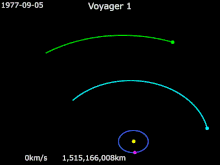
Animation of Voyager 1 's trajectory from September 1977 to Dec 31, 1981
Voyager i ·
Earth·
Jupiter·
Saturn·
Sun

Animation of Voyager one 's trajectory around Jupiter
Voyager 1 ·
Jupiter·
Io·
Europa·
Ganymede·
Callisto

The trajectory of Voyager ane through the Jupiter arrangement
The Voyager i probe was launched on September 5, 1977, from Launch Complex 41 at the Cape Canaveral Air Force Station, aboard a Titan IIIE launch vehicle. The Voyager 2 probe had been launched two weeks earlier, on August twenty, 1977. Despite beingness launched later, Voyager 1 reached both Jupiter[34] and Saturn sooner, following a shorter trajectory.[35]
Voyager 1 's initial orbit had an aphelion of eight.ix AU (830 million mi), just a little brusque of Saturn'southward orbit of 9.5 AU (880 one thousand thousand mi). Voyager 2 'south initial orbit had an aphelion of 6.two AU (580 1000000 mi), well curt of Saturn'due south orbit.[36]
Flyby of Jupiter [edit]
Voyager i began photographing Jupiter in January 1979. Its closest approach to Jupiter was on March 5, 1979, at a distance of well-nigh 349,000 kilometers (217,000 miles) from the planet'south center.[34] Considering of the greater photographic resolution allowed past a closer approach, most observations of the moons, rings, magnetic fields, and the radiation belt environment of the Jovian system were made during the 48-hour period that bracketed the closest arroyo. Voyager 1 finished photographing the Jovian system in April 1979.[37]
The discovery of ongoing volcanic activity on the moon Io was probably the greatest surprise. It was the first fourth dimension agile volcanoes had been seen on another body in the Solar System. It appears that activity on Io affects the entire Jovian system. Io appears to be the main source of matter that pervades the Jovian magnetosphere – the region of space that surrounds the planet influenced past the planet's strong magnetic field. Sulfur, oxygen, and sodium, manifestly erupted by Io'south volcanoes and sputtered off the surface by the impact of high-energy particles, were detected at the outer edge of the magnetosphere of Jupiter.[34]
The 2 Voyager space probes fabricated a number of important discoveries virtually Jupiter, its satellites, its radiation belts, and its never-before-seen planetary rings.
-
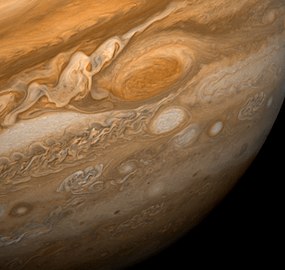
Jupiter'due south Keen Ruddy Spot, an anti-cyclonic storm larger than Earth, as seen from Voyager one
-

View of sulfur-rich lava flows radiating from the volcano Ra Patera on Io
-

The eruption feather of the volcano Loki rises 160 km (100 mi) over the limb of Io
-

Europa's lineated merely un-cratered face up, evidence of currently active geology, at a distance of two.eight million km.
-

Ganymede's tectonically disrupted surface, marked with vivid touch on sites, from 253,000 km.
Flyby of Saturn [edit]
The gravitational assist trajectories at Jupiter were successfully carried out by both Voyagers, and the two spacecraft went on to visit Saturn and its organisation of moons and rings. Voyager 1 encountered Saturn in November 1980, with the closest approach on November 12, 1980, when the space probe came within 124,000 kilometers (77,000 mi) of Saturn'south cloud-tops. The space probe's cameras detected complex structures in the rings of Saturn, and its remote sensing instruments studied the atmospheres of Saturn and its giant moon Titan.[38]
Voyager ane plant that near seven percent of the volume of Saturn's upper atmosphere is helium (compared with 11 percent of Jupiter'due south temper), while almost all the balance is hydrogen. Since Saturn'south internal helium abundance was expected to be the same as Jupiter'south and the Sun's, the lower affluence of helium in the upper atmosphere may imply that the heavier helium may exist slowly sinking through Saturn'due south hydrogen; that might explain the excess heat that Saturn radiates over energy it receives from the Sun. Winds blow at loftier speeds on Saturn. About the equator, the Voyagers measured winds virtually 500 m/s (1,100 mph). The wind blows mostly in an easterly management.[35]
The Voyagers found aurora-like ultraviolet emissions of hydrogen at mid-latitudes in the atmosphere, and auroras at polar latitudes (higher up 65 degrees). The loftier-level auroral activity may lead to the formation of complex hydrocarbon molecules that are carried toward the equator. The mid-latitude auroras, which occur only in sunlit regions, remain a puzzle, since bombardment by electrons and ions, known to cause auroras on Earth, occurs primarily at high latitudes. Both Voyagers measured the rotation of Saturn (the length of a day) at x hours, 39 minutes, 24 seconds.[38]
Voyager 1 's mission included a flyby of Titan, Saturn's largest moon, which had long been known to have an atmosphere. Images taken by Pioneer 11 in 1979 had indicated the atmosphere was substantial and complex, further increasing interest. The Titan flyby occurred as the spacecraft entered the arrangement to avoid any possibility of damage closer to Saturn compromising observations, and approached to within vi,400 km (4,000 mi), passing behind Titan equally seen from Earth and the Lord's day. Voyager's measurement of the atmosphere's effect on sunlight and Earth-based measurement of its effect on the probe'southward radio signal were used to determine the temper's composition, density, and pressure. Titan'southward mass was also measured past observing its upshot on the probe's trajectory. The thick haze prevented whatever visual observation of the surface, but the measurement of the atmosphere's composition, temperature, and pressure level led to speculation that lakes of liquid hydrocarbons could exist on the surface.[39]
Because observations of Titan were considered vital, the trajectory chosen for Voyager ane was designed around the optimum Titan flyby, which took information technology below the southward pole of Saturn and out of the plane of the ecliptic, ending its planetary science mission.[xl] Had Voyager 1 failed or been unable to observe Titan, Voyager two'southward trajectory would take been contradistinct to comprise the Titan flyby,[39] : 94 precluding any visit to Uranus and Neptune.[5] The trajectory Voyager 1 was launched into would not have allowed it to keep on to Uranus and Neptune,[40] : 155 only could have been altered to avoid a Titan flyby and travel from Saturn to Pluto, arriving in 1986.[vii]
-
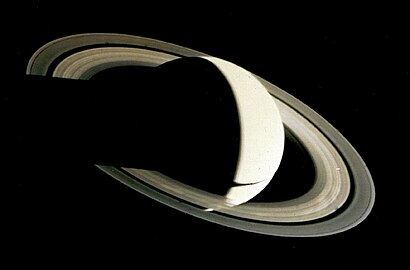
Crescent Saturn from 5.3 million km, four days after closest approach
-

Mimas at a range of 425,000 km; the crater Herschel is at upper right
Get out from the heliosphere [edit]

The Family unit Portrait of the Solar Organisation acquired past Voyager 1 (Feb xiv, 1990)


Position of Voyager 1 above the plane of the ecliptic on Feb 14, 1990, the day Family Portrait was taken.

Voyager one and 2 speed and distance from Sun
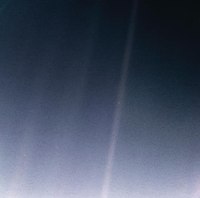
The Pale Blue Dot image showing Globe from half dozen billion kilometers (3.seven billion miles) appearing every bit a tiny dot (the blueish-white speck approximately halfway downwards the light band to the right) within the darkness of deep space.[41]
On February 14, 1990, Voyager 1 took the first "family portrait" of the Solar System as seen from outside,[42] which includes the prototype of planet Earth known as Pale Bluish Dot. Shortly afterwards, its cameras were deactivated to conserve energy and estimator resources for other equipment. The camera software has been removed from the spacecraft, so information technology would at present exist complex to get them working once more. Earth-side software and computers for reading the images are likewise no longer available.[5]
On Feb 17, 1998, Voyager 1 reached a distance of 69 AU (6.four billion mi; 10.three billion km) from the Sun and overtook Pioneer 10 equally the most distant spacecraft from Earth.[43] [44] Travelling at well-nigh 17 km/s (11 mi/southward),[45] it has the fastest heliocentric recession speed of any spacecraft.[46]
As Voyager 1 headed for interstellar space, its instruments continued to report the Solar Organisation. Jet Propulsion Laboratory scientists used the plasma wave experiments aboard Voyager one and 2 to wait for the heliopause, the purlieus at which the solar wind transitions into the interstellar medium.[47] As of 2013[update], the probe was moving with a relative velocity to the Sunday of near 61,197 kilometers per hour (38,026 mph).[48] With the velocity the probe is currently maintaining, Voyager one is traveling about 523 1000000 km (325 million mi) per twelvemonth,[49] or almost one lite-year per 18,000 years.
Termination shock [edit]

Scientists at the Johns Hopkins University Applied Physics Laboratory believe that Voyager 1 entered the termination stupor in February 2003.[l] This marks the signal where the solar wind slows to subsonic speeds. Some other scientists expressed doubt, discussed in the periodical Nature of November vi, 2003.[51] The upshot would not be resolved until other data became available, since Voyager 1 'due south solar-wind detector ceased operation in 1990. This failure meant that termination shock detection would have to be inferred from the information from the other instruments on board.[52] [53] [54]
In May 2005, a NASA press release said that the consensus was that Voyager 1 was so in the heliosheath.[55] In a scientific session at the American Geophysical Union meeting in New Orleans on May 25, 2005, Dr. Ed Stone presented evidence that the craft crossed the termination shock in tardily 2004.[56] This result is estimated to have occurred on December xv, 2004, at a distance of 94 AU (8,700 one thousand thousand mi) from the Sun.[56] [57]
Heliosheath [edit]
On March 31, 2006, amateur radio operators from AMSAT in Frg tracked and received radio waves from Voyager 1 using the 20-meter (66 ft) dish at Bochum with a long integration technique. Retrieved data was checked and verified against information from the Deep Space Network station at Madrid, Spain.[58] This seems to be the first such amateur tracking of Voyager 1.[58]
It was confirmed on Dec 13, 2010, that Voyager 1 had passed the reach of the radial outward flow of the solar current of air, as measured past the Low Energy Charged Particle device. It is suspected that solar wind at this distance turns sideways considering of interstellar wind pushing against the heliosphere. Since June 2010, detection of solar wind had been consistently at zero, providing conclusive evidence of the consequence.[59] [60] On this date, the spacecraft was approximately 116 AU (17.iv billion km; x.8 billion mi) from the Sun.[61]
Voyager one was allowable to alter its orientation to measure the sideways motion of the solar wind at that location in space in March 2011 (~33yr 6mo from launch). A test gyre done in February had confirmed the spacecraft'due south ability to maneuver and reorient itself. The course of the spacecraft was not changed. Information technology rotated seventy degrees counterclockwise with respect to Globe to detect the solar wind. This was the first fourth dimension the spacecraft had done any major maneuvering since the Family Portrait photograph of the planets was taken in 1990. After the start roll the spacecraft had no problem in reorienting itself with Alpha Centauri, Voyager one'due south guide star, and information technology resumed sending transmissions back to Globe. Voyager i was expected to enter interstellar space "at whatsoever time". Voyager 2 was still detecting outward flow of solar wind at that point just it was estimated that in the following months or years it would experience the same atmospheric condition as Voyager 1.[62] [63]
The spacecraft was reported at 12.44° declination and 17.163 hours right ascent, and at an ecliptic breadth of 34.9° (the ecliptic latitude changes very slowly), placing information technology in the constellation Ophiuchus every bit observed from the World on May 21, 2011.[5]
On December 1, 2011, information technology was announced that Voyager 1 had detected the first Lyman-alpha radiation originating from the Galaxy galaxy. Lyman-alpha radiation had previously been detected from other galaxies, but because of interference from the Sunday, the radiations from the Milky way was not detectable.[64]
NASA announced on December 5, 2011, that Voyager 1 had entered a new region referred to as a "catholic purgatory". Within this stagnation region, charged particles streaming from the Sun slow and plough inwards, and the Solar System's magnetic field is doubled in forcefulness as interstellar space appears to be applying pressure. Energetic particles originating in the Solar System refuse by nearly half, while the detection of high-free energy electrons from outside increases 100-fold. The inner edge of the stagnation region is located approximately 113 AU from the Sun.[65]
Heliopause [edit]
NASA announced in June 2012 that the probe was detecting changes in the environment that were suspected to correlate with inflow at the heliopause.[66] Voyager 1 had reported a marked increment in its detection of charged particles from interstellar space, which are normally deflected by the solar winds inside the heliosphere from the Dominicus. The craft thus began to enter the interstellar medium at the edge of the Solar System.[67]
Voyager ane became the showtime spacecraft to cross the heliopause in August 2012, then at a distance of 121 AU (i.12×ten10 mi; i.81×1010 km) from the Sun, although this was not confirmed for some other yr.[68] [69] [seventy] [71] [72]
Every bit of September 2012, sunlight took 16.89 hours to get to Voyager one which was at a altitude of 121 AU. The apparent magnitude of the Sun from the spacecraft was -sixteen.3 (most thirty times brighter than the full Moon).[73] The spacecraft was traveling at 17.043 km/s (x.590 mi/southward) relative to the Sun. It would need nigh 17,565 years at this speed to travel a light-year.[73] To compare, Proxima Centauri, the closest star to the Sun, is almost 4.two light-years ( 2.65×10v AU) afar. Were the spacecraft traveling in the direction of that star, 73,775 years would pass before Voyager 1 would reach it. (Voyager 1 is heading in the management of the constellation Ophiuchus.[73])
In late 2012, researchers reported that particle data from the spacecraft suggested that the probe had passed through the heliopause. Measurements from the spacecraft revealed a steady rising since May in collisions with loftier free energy particles (in a higher place 70 MeV), which are idea to be cosmic rays emanating from supernova explosions far beyond the Solar System, with a sharp increase in these collisions in late August. At the aforementioned time, in late August, there was a dramatic drib in collisions with depression-free energy particles, which are thought to originate from the Sunday.[74]
Ed Roelof, space scientist at Johns Hopkins Academy and principal investigator for the Depression-Energy Charged Particle instrument on the spacecraft, declared that "most scientists involved with Voyager 1 would agree that [these two criteria] accept been sufficiently satisfied".[74] However, the last criterion for officially declaring that Voyager 1 had crossed the boundary, the expected alter in magnetic field direction (from that of the Sun to that of the interstellar field beyond), had non been observed (the field had changed direction by only 2 degrees[69]), which suggested to some that the nature of the edge of the heliosphere had been misjudged.
On December 3, 2012, Voyager project scientist Ed Stone of the California Constitute of Engineering science said, "Voyager has discovered a new region of the heliosphere that nosotros had not realized was there. We're still inside, plainly. But the magnetic field now is continued to the outside. And so it'due south like a highway letting particles in and out."[75] The magnetic field in this region was 10 times more intense than Voyager 1 encountered before the termination shock. It was expected to exist the concluding barrier before the spacecraft exited the Solar System completely and entered interstellar infinite.[76] [77] [78]
Interstellar medium [edit]
In March 2013, information technology was announced that Voyager i might accept become the beginning spacecraft to enter interstellar space, having detected a marked modify in the plasma environment on August 25, 2012. However, until September 12, 2013, it was even so an open question as to whether the new region was interstellar space or an unknown region of the Solar System. At that fourth dimension, the onetime culling was officially confirmed.[79] [80]
In 2013 Voyager 1 was exiting the Solar Organisation at a speed of about 3.vi AU (330 1000000 mi; 540 1000000 km) per year, while Voyager 2 is going slower, leaving the Solar System at iii.3 AU (310 1000000 mi; 490 million km) per year.[81] Each year, Voyager 1 increases its lead over Voyager 2.
Voyager ane reached a distance of 135 AU (12.5 billion mi; 20.2 billion km) from the Sun on May 18, 2016.[3] On September 5, 2017, that had increased to well-nigh 139.64 AU (12.980 billion mi; twenty.890 billion km) from the Lord's day, or simply over 19 light-hours; at that time, Voyager ii was 115.32 AU (10.720 billion mi; 17.252 billion km) from the Sun.[3]
Its progress tin can exist monitored at NASA's website (see § External links).[3]
-
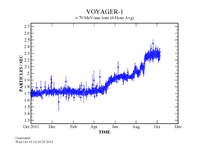
Plot showing a dramatic increase in the rate of cosmic ray particle detection by the Voyager 1 spacecraft (October 2011 through October 2012)
-

Plot showing a dramatic subtract in the rate of solar wind particle detection past Voyager 1 (October 2011 through October 2012)

Voyager ane and the other probes that are in or on their way to interstellar space, except New Horizons.
Voyager 1 transmitted audio signals generated by plasma waves from interstellar infinite
On September 12, 2013, NASA officially confirmed that Voyager 1 had reached the interstellar medium in August 2012 as previously observed. The generally accepted date of arrival is August 25, 2012 (approximately ten days earlier the 35th anniversary of its launch), the date durable changes in the density of energetic particles were first detected.[lxx] [71] [72] Past this signal, most space scientists had abandoned the hypothesis that a change in magnetic field direction must back-trail a crossing of the heliopause;[71] a new model of the heliopause predicted that no such modify would be plant.[82]
A primal finding that persuaded many scientists that the heliopause had been crossed was an indirect measurement of an lxxx-fold increment in electron density, based on the frequency of plasma oscillations observed beginning on April nine, 2013,[71] triggered by a solar flare-up that had occurred in March 2012[68] (electron density is expected to be two orders of magnitude college exterior the heliopause than within).[70] Weaker sets of oscillations measured in October and November 2012[80] [83] provided additional data. An indirect measurement was required because Voyager ane's plasma spectrometer had stopped working in 1980.[72] In September 2013, NASA released recordings of audio transductions of these plasma waves, the outset to be measured in interstellar space.[84]
While Voyager 1 is commonly spoken of as having left the Solar System simultaneously with having left the heliosphere, the ii are not the same. The Solar System is ordinarily divers every bit the vastly larger region of infinite populated by bodies that orbit the Lord's day. The craft is shortly less than ane-seventh the distance to the aphelion of Sedna, and it has not yet entered the Oort deject, the source region of long-period comets, regarded by astronomers every bit the outermost zone of the Solar System.[69] [80]
In Oct 2020, astronomers reported a significant unexpected increase in density in the infinite beyond the Solar System as detected by the Voyager 1 and Voyager 2 space probes. According to the researchers, this implies that "the density gradient is a large-calibration feature of the VLISM (very local interstellar medium) in the general direction of the heliospheric olfactory organ".[85] [86]
In May 2021, NASA reported on the continuous measurement, for the first fourth dimension, of the density of cloth in interstellar space and, as well, the detection of interstellar sounds for the first time.[87]
In May 2022, NASA reported that Voyager ane had begun transmitting "mysterious" and "peculiar" telemetric data to the Deep Space Network (DSN). It confirmed that the operational status of the craft remained unchanged, merely that the issue stemmed from the Attitude Articulation and Command System (AACS). NASA'south Jet Propulsion Laboratory (JPL) published a statement on May eighteen, 2022 that the AACS was functional only sending invalid data.[88] [89] The problem was eventually traced to the AACS sending its telemetry through a estimator that had been non-operational for years, resulting in data corruption. In August 2022, NASA transmitted a control to the AACS to utilize another calculator, which resolved the problem. An investigation into what caused the initial switch is underway, though engineers take hypothesized that the AACS had executed a bad command from another onboard reckoner.[90] [91]
Future of the probe [edit]
| Probe | Velocity ( ) |
|---|---|
| Pioneer 10 | xi.8 km/s (2.49 au/yr) |
| Pioneer 11 | xi.one km/s (two.34 au/yr) |
| Voyager i | 16.nine km/southward (three.57 au/twelvemonth)[92] |
| Voyager ii | 15.ii km/southward (3.21 au/yr) |
| New Horizons | 12.half dozen km/due south (two.66 au/year) |
Remaining lifespan [edit]

Image of Voyager i 's radio signal on February 21, 2013[93]
In December 2017, NASA successfully fired up all iv of Voyager i 's trajectory correction maneuver (TCM) thrusters for the first time since 1980. The TCM thrusters will be used in the place of a degraded set of jets which were used to help go on the probe's antenna pointed towards the World. Employ of the TCM thrusters will permit Voyager 1 to go along to transmit data to NASA for two to iii more years.[94] [95]
Due to the diminishing electrical power available, the Voyager squad has had to prioritize which instruments to keep on and which to plough off. Heaters and other spacecraft systems take been turned off one past one as office of ability direction. The fields and particles instruments that are the virtually probable to send back cardinal data about the heliosphere and interstellar space accept been prioritized to keep operating. Engineers expect the spacecraft to continue operating at least one science instrument until around 2025.[96]
| Year | End of specific capabilities as a result of the available electrical power limitations |
|---|---|
| 1998 | Termination of Ultraviolet Spectrometer (UVS)[97] |
| 2007 | Termination of plasma subsystem (PLS)[98] |
| 2008 | Ability off Planetary Radio Astronomy Experiment (PRA)[98] |
| 2016 | Termination of browse platform and Ultraviolet Spectrometer (UVS) observations[99] |
| Unknown date | Outset shutdown of science instruments (equally of October xviii, 2010[update] the guild is undecided, still the Low-Energy Charged Particles, Cosmic Ray Subsystem, Magnetometer, and Plasma Moving ridge Subsystem instruments are expected to still be operating)[98] |
| Unknown date | Termination of Data Record Recorder (DTR) operations (limited by power to capture one.4 kbit/s data using a lxx yard/34 m antenna array; this is the minimum rate at which the DTR can read out information).[98] |
| Unknown date | Termination of gyroscopic operations (previously 2017, simply backup thrusters active for continuation of gyroscopic operations.)[98] |
| 2025–2036 | Will no longer exist able to ability even a single instrument. After 2036, both probes will be out of range of the Deep Infinite Network.[12] |
Far hereafter [edit]
-
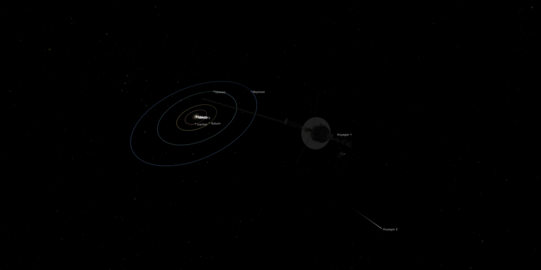
Simulated view of Voyager 1 relative to the Solar Arrangement on August 2, 2018.
-

Simulated view of the Voyager probes relative to the Solar System and heliopause on Baronial ii, 2018.
-
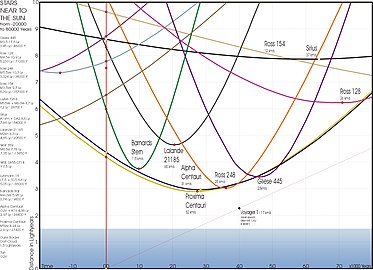
In about l,000 years Voyager 1 volition exist as distant as several nearby stars
Provided Voyager i does non collide with anything and is not retrieved, the New Horizons infinite probe will never pass it, despite beingness launched from Earth at a college speed than either Voyager spacecraft. The Voyager spacecraft benefited from multiple planetary flybys to increase its heliocentric velocities, whereas New Horizons received only a single such boost, from its Jupiter flyby. As of 2018[update], New Horizons is traveling at about 14 km/s (8.seven mi/s), iii km/s (1.nine mi/s) slower than Voyager 1 and is still slowing downward.[100]
Voyager ane is expected to reach the theorized Oort cloud in about 300 years[101] [102] and take about thirty,000 years to pass through it.[69] [80] Though it is not heading towards any particular star, in about forty,000 years, it will laissez passer inside 1.6 light-years (0.49 parsecs) of the star Gliese 445, which is at present in the constellation Camelopardalis and 17.one light-years from World.[103] That star is generally moving towards the Solar System at about 119 km/s (430,000 km/h; 270,000 mph).[103] NASA says that "The Voyagers are destined—peradventure eternally—to wander the Milky Way."[104] In 300,000 years, it will laissez passer within less than 1 lite yr of the M3V star TYC 3135-52-1.[105]
Aureate record [edit]

Each Voyager space probe carries a gold-plated acoustic disc, should the spacecraft ever exist found by intelligent life forms from other planetary systems.[106] The disc carries photos of the Earth and its lifeforms, a range of scientific information, spoken greetings from people such equally the Secretary-General of the United nations and the President of the United States and a medley, "Sounds of Earth," that includes the sounds of whales, a baby crying, waves breaking on a shore, and a drove of music including works past Wolfgang Amadeus Mozart, Blind Willie Johnson, Chuck Berry and Valya Balkanska. Other Eastern and Western classics are included, also equally various performances of indigenous music from effectually the world. The record as well contains greetings in 55 dissimilar languages.[107]
Run across also [edit]
- The Farthest, a 2017 documentary on the Voyager program
- Interstellar probe
- List of artificial objects leaving the Solar System
- List of missions to the outer planets
- Local Interstellar Cloud
- Space exploration
- Specific orbital energy of Voyager 1
- Timeline of artificial satellites and space probes
- Voyager ii
References [edit]
- ^ "Voyager 1". NSSDC Master Catalog. NASA/NSSDC. Retrieved August 21, 2013.
- ^ "Voyager 1". N2YO. Retrieved August 21, 2013.
- ^ a b c d e f "Voyager - Mission Status". Jet Propulsion Laboratory. National Aeronautics and Space Administration. Retrieved Nov 21, 2021.
- ^ "Voyager 1". BBC Solar System. Archived from the original on February 3, 2018. Retrieved September 4, 2018.
- ^ a b c d "Voyager – Oftentimes Asked Questions". NASA. February 14, 1990. Retrieved August four, 2017.
- ^ "New Horizons conducts flyby of Pluto in historic Kuiper Belt run into". July 12, 2015. Retrieved September 2, 2015.
- ^ a b "What If Voyager Had Explored Pluto?". Retrieved September 2, 2015.
- ^ "Interstellar Mission". NASA Jet Propulsion Laboratory. Retrieved August 24, 2020.
- ^ Barnes, Brooks (September 12, 2013). "In a Breathtaking Offset, NASA Arts and crafts Exits the Solar Organisation". New York Times . Retrieved September 12, 2013.
- ^ Claven, Whitney (July seven, 2014). "Sunday Sends More 'Tsunami Waves' to Voyager 1". NASA . Retrieved July 8, 2014.
- ^ Wall, Mike (December 1, 2017). "Voyager 1 Just Fired Up its Fill-in Thrusters for the 1st Time in 37 Years". Space.com. Retrieved December three, 2017.
- ^ a b "Voyager – Often Asked Questions". Jet Propulsion Laboratory . Retrieved July thirty, 2020.
- ^ "1960s". JPL. Archived from the original on December 8, 2012. Retrieved August eighteen, 2013.
- ^ "The Pioneer missions". NASA. 2007. Retrieved August xix, 2013.
- ^ "Preview Screening: The Farthest - Voyager in Infinite". informal.jpl.nasa.gov. NASA Museum Alliance. August 2017. Retrieved August eighteen, 2019.
supermarket aluminum foil added at the last minute to protect the craft from radiation
- ^ Mack, Pamela (1998). "Chapter eleven". From engineering science to big science: The NACA and NASA Collier Trophy research project winners. History Office. p. 251. ISBN978-0-16-049640-0.
- ^ Landau, Elizabeth (October 2, 2013). "Voyager 1 becomes kickoff homo-fabricated object to leave solar system". CNN. CNN. Retrieved May 29, 2014.
- ^ "NASA Spacecraft Embarks on Historic Journey into Interstellar Infinite". NASA. September 12, 2013. Retrieved May 29, 2014.
NASA'south Voyager 1 spacecraft officially is the first human being-made object to venture into interstellar space.
- ^ "Viking: Trailblazer for All Mars Inquiry". NASA. June 22, 2006. Retrieved May 29, 2014.
All of these missions relied on Viking technologies. As it did for the Viking programme team in 1976, Mars continues to hold a special fascination. Thanks to the dedication of men and women working at NASA centers beyond the land, the mysterious Mars of our by is becoming a much more familiar identify.
- ^ a b "VOYAGER ane:Host Data". JPL. 1989. Retrieved Apr 29, 2015.
- ^ "High Gain Antenna". JPL. Retrieved Baronial 18, 2013.
- ^ Ludwig, Roger; Taylor, Jim (March 2002). "Voyager Telecommunications" (PDF). DESCANSO Design and Functioning Summary Serial. NASA/JPL. Retrieved September 16, 2013.
- ^ "NASA News Press Kit 77–136". JPL/NASA. Retrieved December xv, 2014.
- ^ a b Furlong, Richard R.; Wahlquist, Earl J. (1999). "U.S. infinite missions using radioisotope power systems" (PDF). Nuclear News. 42 (4): 26–34.
- ^ "Spacecraft Lifetime". JPL. Retrieved Baronial 19, 2013.
- ^ "pds-rings". Retrieved May 23, 2015.
- ^ Tomayko, James (April 1987). Computers in Spaceflight: The NASA Feel. NASA. Bibcode:1988csne.book.....T. Retrieved February 6, 2010.
- ^ "au.af". Archived from the original on October sixteen, 2015. Retrieved May 23, 2015.
- ^ "airandspace". Retrieved May 23, 2015.
- ^ "Voyager 1 Narrow Angle Camera Description". NASA. Retrieved January 17, 2011.
- ^ "Voyager 1 Wide Bending Camera Description". NASA. Retrieved January 17, 2011.
- ^ Greicius, Tony (December 1, 2017). "Voyager one Fires Upwardly Thrusters Afterward 37 Years". NASA . Retrieved December 13, 2017.
- ^ According to the Jet Propulsion Laboratory (JPL) status page [1]
- ^ a b c "See with Jupiter". NASA. Retrieved August 18, 2013.
- ^ a b "Planetary voyage". NASA. Retrieved August xviii, 2013.
- ^ HORIZONS, JPL Solar Arrangement Dynamics (Ephemeris Type ELEMENTS; Target Trunk: Voyager north (spacecraft); Center: Sunday (body eye); Time Bridge: launch + 1 month to Jupiter see - 1 calendar month)
- ^ "Voyager - Images Voyager took of Jupiter". voyager.jpl.nasa.gov . Retrieved December 23, 2020.
- ^ a b "Encounter with saturn". NASA. Retrieved August 29, 2013.
- ^ a b Jim Bell (February 24, 2015). The Interstellar Age: Inside the Forty-Year Voyager Mission. Penguin Publishing Grouping. p. 93. ISBN978-0-698-18615-half-dozen.
- ^ a b David Due west. Swift (January ane, 1997). Voyager Tales: Personal Views of the Grand Tour. AIAA. p. 69. ISBN978-1-56347-252-7.
- ^ Staff (Feb 12, 2020). "Pale Blue Dot Revisited". NASA . Retrieved February 12, 2020.
- ^ "Photo Caption". Public Information Office. Retrieved August 26, 2010.
- ^ "Voyager i now most distant man-fabricated object in space". CNN. February 17, 1998. Archived from the original on June xx, 2012. Retrieved July ane, 2012.
- ^ Clark, Stuart (September 13, 2013). "Voyager 1 leaving solar system matches feats of great human explorers". The Guardian.
- ^ Webb, Stephen (Oct four, 2002). If the Universe is Teeming with Aliens … WHERE IS EVERYBODY?: Fifty Solutions to the Fermi Paradox and the Problem of Extraterrestrial Life. ISBN978-0-387-95501-8.
- ^ Darling, David. "Fastest Spacecraft". Retrieved August 19, 2013.
- ^ "Voyager ane in heliopause". JPL. Retrieved August 18, 2013.
- ^ "Mission Status". JPL. Retrieved Feb 14, 2020.
- ^ Wall, Mike (September 12, 2013). "It's Official! Voyager 1 Spacecraft Has Left Solar System". Space.com . Retrieved May 30, 2014.
- ^ Tobin, Kate (November v, 2003). "Spacecraft reaches edge of Solar System". CNN. Retrieved Baronial 19, 2013.
- ^ Fisk, Len A. (2003). "Planetary Science: Over the edge?" (PDF). Nature. 426 (6962): 21–two. Bibcode:2003Natur.426...21F. doi:ten.1038/426021a. PMID 14603294.
- ^ Krimigis, Due south. G.; Decker, R. B.; Hill, M. East.; Armstrong, T. P.; Gloeckler, G.; Hamilton, D. C.; Lanzerotti, 50. J.; Roelof, East. C. (2003). "Voyager ane exited the solar wind at a distance of ~85 au from the Sun". Nature. 426 (6962): 45–8. Bibcode:2003Natur.426...45K. doi:10.1038/nature02068. PMID 14603311. S2CID 4393867.
- ^ McDonald, Frank B.; Stone, Edward C.; Cummings, Alan C.; Heikkila, Bryant; Lal, Nand; Webber, William R. (2003). "Enhancements of energetic particles near the heliospheric termination shock". Nature. 426 (6962): 48–51. Bibcode:2003Natur.426...48M. doi:10.1038/nature02066. PMID 14603312. S2CID 4387317.
- ^ Burlaga, L. F. (2003). "Search for the heliosheath with Voyager i magnetic field measurements" (PDF). Geophysical Research Letters. thirty (xx): n/a. Bibcode:2003GeoRL..xxx.2072B. doi:10.1029/2003GL018291.
- ^ "Voyager Enters Solar Arrangement's Last Borderland". NASA. May 24, 2005. Retrieved August 7, 2007.
- ^ a b "Voyager crosses termination shock". Retrieved August 29, 2013.
- ^ "Voyager Timeline". NASA/JPL. February 2013. Retrieved December 2, 2013.
- ^ a b "ARRL article" (in German). AMSAT-DL. Archived from the original on October fourteen, 2006. "ARRL article".
- ^ "Voyager ane Sees Solar Wind Reject". NASA. December 13, 2010. Archived from the original on June xiv, 2011. Retrieved September 16, 2013.
- ^ Krimigis, S. G.; Roelof, Due east. C.; Decker, R. B.; Hill, Yard. Due east. (2011). "Zero outward catamenia velocity for plasma in a heliosheath transition layer". Nature. 474 (7351): 359–361. Bibcode:2011Natur.474..359K. doi:x.1038/nature10115. PMID 21677754. S2CID 4345662.
- ^ Amos, Jonathan (Dec fourteen, 2010). "Voyager near Solar System's edge". BBC News . Retrieved December 21, 2010.
- ^ NASA. "Voyager – The Interstellar Mission". NASA. Retrieved September xvi, 2013.
- ^ "Voyager: Still dancing 17 billion km from Earth". BBC News. March 9, 2011.
- ^ "Voyager Probes Observe "invisible" Milky way Glow". National Geographic. December ane, 2011. Retrieved Dec 4, 2011.
- ^ "Spacecraft enters 'cosmic purgatory'". CNN. December half-dozen, 2011. Retrieved December seven, 2011.
- ^ "NASA Voyager 1 Spacecraft Nears Interstellar Space". Infinite.com. June 18, 2012. Retrieved Baronial 19, 2013.
- ^ "Data From NASA's Voyager 1 Point to Interstellar Future". NASA. June fourteen, 2012. Retrieved June 16, 2012.
- ^ a b Cook, J.-R. C.; Agle, D.C.; Chocolate-brown, D. (September 12, 2013). "NASA Spacecraft Embarks on Historic Journey into Interstellar Space". NASA . Retrieved September 14, 2013.
- ^ a b c d Ghose, Tia (September 13, 2013). "Voyager 1 Really Is in Interstellar Space: How NASA Knows". Infinite.com. TechMedia Network. Retrieved September 14, 2013.
- ^ a b c Cowen, R. (2013). "Voyager i has reached interstellar space". Nature. doi:10.1038/nature.2013.13735. S2CID 123728719.
- ^ a b c d Kerr, R. A. (2013). "It'due south Official—Voyager Has Left the Solar System". Science. 341 (6151): 1158–1159. Bibcode:2013Sci...341.1158K. doi:x.1126/science.341.6151.1158. PMID 24030991.
- ^ a b c Gurnett, D. A.; Kurth, W. Due south.; Burlaga, L. F.; Ness, Northward. F. (2013). "In Situ Observations of Interstellar Plasma with Voyager 1". Science. 341 (6153): 1489–1492. Bibcode:2013Sci...341.1489G. doi:10.1126/science.1241681. PMID 24030496. S2CID 206550402.
- ^ a b c Peat, Chris (September 9, 2012). "Spacecraft escaping the Solar System". Heavens-Above. Retrieved March xvi, 2014.
- ^ a b Wolchover, Natalie (October 9, 2012). "Did NASA's Voyager 1 Spacecraft Merely Leave the Solar Organisation?". livescience. Retrieved August 20, 2013.
- ^ Matson, John (December 4, 2012). "Despite Tantalizing Hints, Voyager 1 Has Not Crossed into the Interstellar Medium". Scientific American . Retrieved August xx, 2013.
- ^ "Voyager 1 Can 'Gustation' the Interstellar Shore". Discovery News. Discovery Aqueduct. Dec 3, 2012. Retrieved September 16, 2013.
- ^ Oakes, Kelly (Dec three, 2012). "Voyager 1 is still not out of the Solar System". Basic Infinite Blog. Scientific American. Retrieved September 16, 2013.
- ^ "Voyager 1 probe leaving Solar System reaches 'magnetic highway' get out". Daily News & Analysis. Reuters. Dec 4, 2012. Retrieved December 4, 2012.
- ^ "Voyager 1 has entered a new region of space, sudden changes in cosmic rays indicate". American Geophysical Union. March 20, 2013. Archived from the original on March 22, 2013.
- ^ a b c d Cook, J.-R (September 12, 2013). "How Practice We Know When Voyager Reaches Interstellar Space?". NASA / Jet Propulsion Lab. Retrieved September 15, 2013.
- ^ "Voyager - Fast Facts". voyager.jpl.nasa.gov.
- ^ Swisdak, K.; Drake, J. F.; Opher, M. (2013). "A Porous, Layered Heliopause". The Astrophysical Journal. 774 (one): L8. arXiv:1307.0850. Bibcode:2013ApJ...774L...8S. doi:x.1088/2041-8205/774/1/L8. S2CID 118459113.
- ^ Morin, Monte (September 12, 2013). "NASA confirms Voyager 1 has left the Solar Organization". Los Angeles Times.
- ^ "Voyage one Records "Sounds" of Interstellar Space". Space.com. Retrieved December xx, 2013.
- ^ Starr, Michelle (October nineteen, 2020). "Voyager Spacecraft Detect an Increase in The Density of Space Outside The Solar Organization". ScienceAlert . Retrieved October 19, 2020.
- ^ Kurth, W.Due south.; Gurnett, D.A. (August 25, 2020). "Observations of a Radial Density Gradient in the Very Local Interstellar Medium by Voyager 2". The Astrophysical Journal Letters. 900 (i): L1. Bibcode:2020ApJ...900L...1K. doi:x.3847/2041-8213/abae58. S2CID 225312823. Retrieved October 19, 2020.
- ^ Hatfield, Miles; Cofield, Calla (May xi, 2021). "Equally NASA's Voyager one Surveys Interstellar Space, Its Density Measurements Are Making Waves". NASA . Retrieved May 11, 2021.
- ^ Kooser, Amanda. "NASA's Voyager 1 Infinite Probe From the '70s Troubled by Mysterious Glitch". CNET . Retrieved May 24, 2022.
- ^ "Humanity'due south most afar spacecraft is sending back weird signals from across our solar system". MSN . Retrieved May 24, 2022.
- ^ Tariq Malik (Baronial 30, 2022). "NASA solves Voyager 1 data glitch mystery, but finds some other". Infinite.com . Retrieved September 1, 2022.
- ^ Greicius, Tony (August 30, 2022). "Engineers Solve Data Glitch on NASA's Voyager 1". NASA . Retrieved September 1, 2022.
- ^ Voyager Fast Facts
- ^ "Voyager Signal Spotted By Earth Radio Telescopes". NASA. NASA Television set. September 5, 2013. Retrieved May xx, 2015.
- ^ "Voyager 1 spacecraft thrusters fire upwards subsequently decades idle". The Irish Times. December 4, 2017.
- ^ "Voyager 1 Fires Upwards Thrusters After 37 Years". NASA. December 1, 2017.
- ^ "Voyager - Oft Asked Questions". voyager.jpl.nasa.gov . Retrieved June 26, 2020.
- ^ "Voyager - Mission Status". NASA.
- ^ a b c d e "Voyager: Operations Program to the End Mission". NASA.
- ^ "Voyager - Mission Status". voyager.jpl.nasa.gov.
- ^ "New Horizons Salutes Voyager". New Horizons. Baronial 17, 2006. Archived from the original on November 13, 2014. Retrieved November iii, 2009.
- ^ "Itemize Folio for PIA17046". Photo Journal. NASA. Retrieved April 27, 2014.
- ^ "It's Official: Voyager 1 Is At present In Interstellar Space". UniverseToday. September 12, 2013. Retrieved April 27, 2014.
- ^ a b "Voyager – Mission – Interstellar Mission". NASA. August 9, 2010. Retrieved March 17, 2011.
- ^ "Hereafter". NASA. Retrieved Oct 13, 2013.
- ^ Bailer-Jones, Coryn A. L.; Farnocchia, Davide (April 3, 2019). "Future stellar flybys of the Voyager and Pioneer spacecraft". Research Notes of the AAS. 3 (iv): 59. arXiv:1912.03503. Bibcode:2019RNAAS...3...59B. doi:10.3847/2515-5172/ab158e. S2CID 134524048.
- ^ Ferris, Timothy (May 2012). "Timothy Ferris on Voyagers' Never-Ending Journey". Smithsonian Magazine. Archived from the original on Nov 4, 2013. Retrieved August xix, 2013.
- ^ "Voyager Aureate tape". JPL. Retrieved August xviii, 2013.
External links [edit]
![]()
Wikimedia Commons has media related to Voyager 1.
- NASA Voyager website
- Voyager 1 Mission Contour past NASA's Solar System Exploration
- Position of Voyager 1 (Live-Counter)
- Voyager ane (NSSDC Main Catalog)
- Heavens-above.com: Spacecraft Escaping the Solar Organisation – current positions and diagrams
- JPL Voyager Telecom Manual
- Voyager 1 Has Outdistanced the Solar Wind
- Gray, Meghan. "Voyager and Interstellar Space". Deep Space Videos. Brady Haran.
- WebGL-based 3D creative person's view of Voyager @ SPACECRAFTS 3D
1&1 Dsl Bestandskunden Angebote Zur Vertragsverlängerung,
Source: https://en.wikipedia.org/wiki/Voyager_1
Posted by: eganshopean.blogspot.com



0 Response to "1&1 Dsl Bestandskunden Angebote Zur Vertragsverlängerung"
Post a Comment